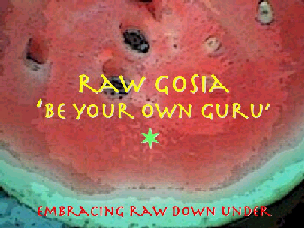
| Main | My story | Recipes | Tips | Articles | Interviews | Photos | Journal | Links |
| Shared joy is a double joy; shared sorrow is half a sorrow. (Swedish proverb) |
Only your real friends will tell you when your face is dirty.
(Sicilian proverb) |
Your friend is that man who knows all about you, and still
likes you. (Elbert Hubbard) |
You can always tell a real friend; when you've made a fool of
yourself he doesn't feel you've done a permanent job. (Laurence J. Peter) |
Friends are family you choose for yourself. |
| 2008 January February March April May June July August September October November December 7th July, 2008
Here is a little story I recently shared on the rawpleasure forum: Fly High!!!
<> Fly high,
dear friend. My beautiful friend.
So unbelievably beautiful.
18th
July,
2008I would like to preserve some interesting titbits before they vanish into non-existence on the discussion boards. For example this one, a little bit of factual information which I searched for, found and collected, after failing to get the hard-core answers from others: I know where the 2000cal figure is coming from! Are you interested? I did some searching and reading and finally learned that this is based on so called Harris-Benedict equation used to estimate so called basal metabolic rate (BMR). BMR is defined as the amount of energy expended while at rest in a neutrally temperate environment, in the post-absorptive state (meaning that the digestive system is inactive, which requires about twelve hours of fasting in humans). BMR is measured under very restrictive circumstances when a person is awake, but at complete rest. An accurate BMR measurement requires that the person's sympathetic nervous system not be stimulated. BMR is measured by gas analysis through either direct or indirect calorimetry. Now, the Harris-Benedict equation is an equation that one can use to estimate their BMR. How was this equation obtained? Well, measurements on 136 men, 103 women and 94 new-born infants have been analyzed biometrically with the purpose of determining the statistical constants (means, standard deviations, etc) (see ref: A BIOMETRIC STUDY OF HUMAN BASAL METABOLISM, BY J. ARTHUR HARRIS AND FRANCIS G. BENEDICT). The authors of the method emphasize (and from my background in probability and statistics I understand why): "In carrying out this analysis we have proceeded on the conviction that the widest possible usefulness of laboratory investigations of human metabolism will result from basing measurements upon individuals who are in presumably good health, but who are otherwise typical of the population at large. It is only when the subjects used for experimentation are representative of the general population in type, variability and correlation that results of laboratory research upon limited series of individuals may be safely generalized for rationing or for other practical social applications." So, from the authors of the very method, we hear that the method is only suitable when used to individuals similar to those that they studied! And, clearly they formula is only an average from the sample they studied, in which they obtained different measurements for each individual they looked at. And, hear this: In the studies of BMR, it has been shown that illness, previously consumed food and beverages, environmental temperature, and stress levels can affect one's overall energy expenditure as well as one's BMR. And the formula? * for men, P = 13.7516m + 5.0033h + 6.7550a + 66.4730 * for women, P = 9.6354m + 1.8496h - 4.6756a + 655.0955 where P is total heat production at complete rest, m is the weight (in kg), h is the stature (height, in cm), and a is the age (in years), and with the difference in BMR for men and women being mainly due to differences in body weight. For example, a 55 year old woman weighing 130 lb (59 kg) and 5 feet 6 inches (168 cm) tall would have a BMR of 1266 (aha!) kcal per day or 52.8 kcal/h (61.3 watts). Or, a 25 year old man weighing 70 kg and 180 cm tall would have a BMR of 2098 kcal per day (hence the popular 2000 figure). It was the best prediction equation until recently, when MD Mifflin and ST St Jeor in 1990 created new equation: * for men, P = 9.99m + 6.25h - 4.92a +5 -161 * for women, P = 9.99m + 6.25h - 4.92a -161 According to this formula, the woman in the example above has a BMR of 1208 kcal per day. During the last 100 years, lifestyles have changed and a survey in 2005 showed it to be about 5% more accurate. In conclusion, to obtain a formula useful for raw foodists, a study is required to be done on a sample representative of raw foodists. Sharing some fine Polish music with you, dear reader (I can hear elements of Polish folk in this piece, my Polish-Aboriginal ancestors calling my soul, the echoing music of the mountains): 22nd July 2008 I do not ever seem to get tempted by the taste or smell etc of cooked foods anymore. After 5 years of raw, my tastebuds demand juicy and fresh things all the time. However, the emotional stuff still gets me sometimes. These videos (link to part 1 given below) on the topic of emotional eating seems interesting enough to have caught my attention: Interesting enough? This is superb!!! :))) next Top of the page |